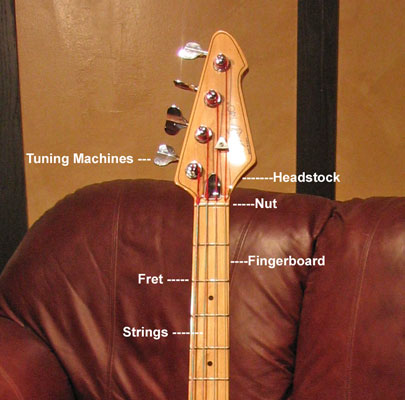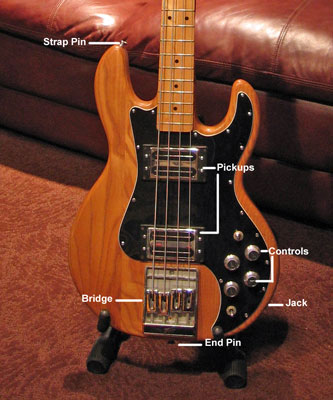The neck
The neck of the bass guitar falls under the dominion of the fretting hand (usually the left hand).
The headstock is the top of the neck and holds the tuning machines.
The tuning machines hold the ends of the strings. By turning the individual tuning heads, you can increase or decrease the tension of the strings.
The nut is a piece of wood, plastic, graphite, or brass that provides a groove for each string.
The fingerboard is the flat side of the neck, beneath the strings, that holds the frets.
The frets are the thin metal strips that are embedded along the length of the fingerboard. They determine the pitch (sound) of the note that’s played.
The back of the neck refers to the part of the neck that the thumb of your fretting hand rests on.
The strings aren't, strictly speaking, part of your bass, but your bass would be absolutely useless without them. The vibration of the strings produces the sound of your bass.

The body
The body of the bass guitar is the playground of the striking hand (usually the right hand).
The pickups consist of magnets that are embedded in a plastic bar that lies underneath and perpendicular to the strings. The magnets form a magnetic field, and the vibration of the string disturbs (or modulates) that field, which is translated into an electric signal and converted into sound.
The controls are the knobs used for adjusting the volume and tone (bass and treble) of the pickups.
The bridge is where the strings are attached to the body. Modern pickups, such as piezo pickups or lightwave pickups, are sometimes installed inside the bridge.
The strap pin is the metal knob on the neck end of the body where you attach one end of your shoulder strap (usually the thick end).
The end pin is the metal knob on the bottom end of the body (by the bridge) where you attach the thin end of your shoulder strap.
The jack (also called the input jack) is the socket used for connecting the cord from your bass to the amplifier.

The innards
A bass guitar's innards aren’t obvious to the eye (they’re hidden in the cavity of the instrument and covered with plates), but they're essential to the sound and feel of the bass guitar.
The truss rod is an adjustable metal rod that runs the length of your bass guitar’s neck.
The electronics are a collection of wires, pots (electronic capacitors, the round devices connected to the other side of a volume knob), and other important-looking electronic items that help convert the vibration of the string into sound.
If your bass has active electronics (electronics with their own power source), you have one or two nine-volt batteries attached to the electronics (via some wires).
dummies
Source:http://www.dummies.com/how-to/content/the-anatomy-of-a-bass-guitar.html
No comments:
Post a Comment